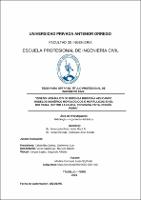| dc.contributor.advisor | Medina Carbajal, Lucio Sigifredo | |
| dc.contributor.author | Amesquita Ruiz, Víctor Raúl Jr | |
| dc.contributor.author | Casas Pereda, Ericksson José Teófilo | |
| dc.creator | Amesquita Ruiz, Víctor Raúl Jr | |
| dc.date.accessioned | 2022-06-02T04:20:24Z | |
| dc.date.available | 2022-06-02T04:20:24Z | |
| dc.date.issued | 2022 | |
| dc.identifier.uri | https://hdl.handle.net/20.500.12759/9049 | |
| dc.description.abstract | El proyecto de Investigación, nos detalla el uso de herramientas
computacionales como son la modelación numérica, que nos ayuda a
representar el comportamiento hidrológico e hidrodinámico.
Durante el desarrollo de los objetivos específicos, se detallará la metodología a
seguir para diseñar una estructura de protección bajo estos modelos.
Como metas se desarrollará lo siguiente:
Recopilación de información hidrometeréologica
Se desarrolla con la descarga de información meteorológica e hidrológica
mediante la plataforma de Senamhi o de la Autoridad Nacional del Agua, en la
cual se visualiza y se interpreta los datos faltantes, la extensión de la serie
historia, las estaciones cercanas que se puedan usar para la completacion de
datos
Análisis de frecuencia
Se procedió a sacar las máximas de 24 horas para posteriormente utilizar la
ecuación de fuller para obtener las máximas instantáneas anuales para
incorporarlo la serie a Easyfit, en la cual nos ayudara con las distribuciones
probabilísticas para visualizar estadísticamente con pruebas de ajuste cual es la
que tiene mayor ajuste y obtener caudales máximos en diferentes periodos de
retorno.
Modelación hidrológica con Hec-Hms
En esta etapa se incorpora el diseño de tormentas a un modelo Hec-Hms, en la
cual fue construido con la delimitación de la cuenca como dato vectorial en un
sistema de información geográfica (en nuestro caso será ArcGIS), y armar el
modelo a nivel de subcuenca
Modelación hidráulica con Hec-ras
Los hidrogramas resultante del modelo Hechms para cada periodo de retorno de
estudio se incorpora como datos ingreso para las condiciones de borde de aguas
arriba, para ello debe simularse como flujo no permanente. | es_PE |
| dc.description.abstract | The research project details the use of computational tools such as numerical
modeling, which helps us to represent the hydrological and hydrodynamic
behavior.
During the development of the specific objectives, the methodology to be followed
to design a protection structure under these models will be detailed.
As goals, the following will be developed:
Compilation of hydrometeorological information.
It is developed with the download of meteorological and hydrological information
through the Senamhi platform or the National Water Authority, in which the
missing data is visualized and interpreted, the extension of the history series, the
nearby stations that can be used to complete the data.
Frequency analysis
We proceeded to extract the 24-hour maximums to later use the fuller equation
to obtain the annual instantaneous maximums to incorporate the series to Easyfit,
which will help us with the probabilistic distributions to statistically visualize with
adjustment tests which is the one that has the best fit and obtain maximum flows
in different return periods.
Hydrologic modeling with Hec-Hms
In this stage the storm design is incorporated to a Hec-Hms model, which was
built with the delimitation of the basin as vector data in a geographic information
system (in our case it will be ArcGIS), and build the model at the sub-basin level.
Hydraulic modeling with Hec-ras
The hydrographs resulting from the Hechms model for each study return period
are incorporated as input data for the upstream boundary conditions, which must
be simulated as unsteady flow | en_US |
| dc.description.uri | Tesis | es_PE |
| dc.format | application/pdf | es_PE |
| dc.language.iso | spa | es_PE |
| dc.publisher | Universidad Privada Antenor Orrego | es_PE |
| dc.relation.ispartofseries | T_CIVIL_2072 | |
| dc.rights | info:eu-repo/semantics/openAccess | es_PE |
| dc.rights.uri | https://creativecommons.org/licenses/by/4.0/ | es_PE |
| dc.source | Universidad Privada Antenor Orrego | es_PE |
| dc.source | Repositorio Institucional - UPAO | es_PE |
| dc.subject | Defensa | es_PE |
| dc.subject | Ribereña | es_PE |
| dc.title | Diseño hidráulico de defensa ribereña aplicando modelos numérico hidrológicos e hidráulicos en el Rio Piura, Sector La Huaca, Provincia Paita, Región Piura | es_PE |
| dc.type | info:eu-repo/semantics/bachelorThesis | es_PE |
| thesis.degree.level | Título Profesional | es_PE |
| thesis.degree.grantor | Universidad Privada Antenor Orrego. Facultad de Ingeniería | es_PE |
| thesis.degree.name | Ingeniero Civil | es_PE |
| thesis.degree.discipline | Ingeniería Civil | es_PE |
| dc.subject.ocde | https://purl.org/pe-repo/ocde/ford#2.01.00 | es_PE |
| renati.advisor.orcid | https://orcid.org/0000-0001-5207-4421 | es_PE |
| renati.author.dni | 74985925 | |
| renati.author.dni | 47790677 | |
| renati.advisor.dni | 40534510 | |
| renati.type | https://purl.org/pe-repo/renati/type#tesis | es_PE |
| renati.level | https://purl.org/pe-repo/renati/level#tituloProfesional | es_PE |
| renati.discipline | 732016 | es_PE |
| renati.juror | Cabanillas Quiroz, Guillermo Juan | |
| renati.juror | Vertiz Malabrigo, Manuel Alberto | |
| renati.juror | Vargas López, Segundo Alfredo | |
| dc.publisher.country | PE | es_PE |


